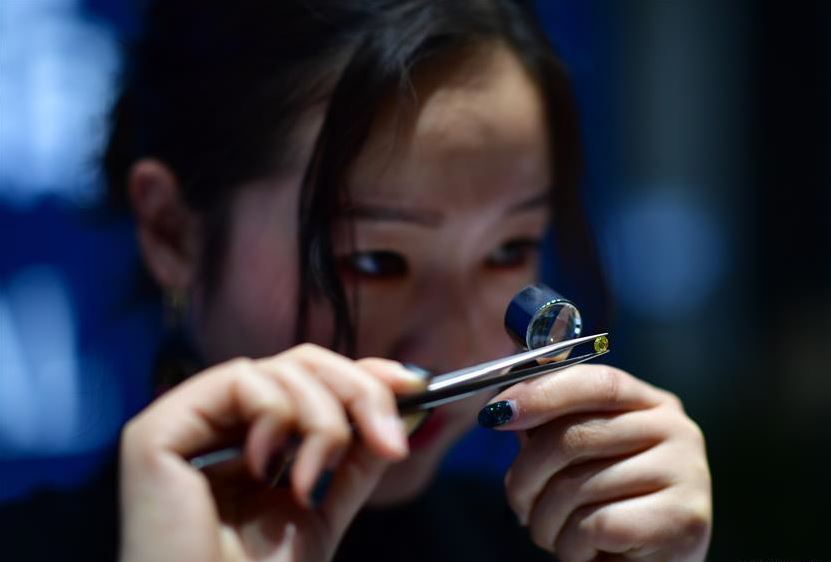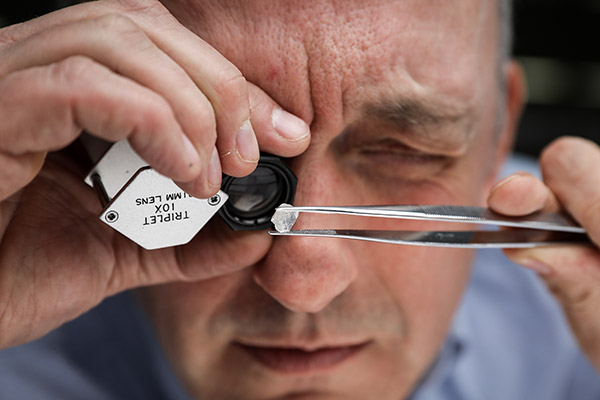
From the People's Daily app.
And this is Story in the Story.
Gem stone analysts expect the man-made diamond jewelry market will grow 22 percent from $1.9 to $5.2 billion by 2023.
China produces over 10 billion carats of diamonds annually for industrial purposes.
Before being cut and polished and then sold for more than $2,000 per carat -- one-fifth of a gram, or the weight of two grains of rice, diamonds have traditionally been mined from the depths well-below Earth's surface.
Chinese companies have mastered the technology necessary to mass produce synthetic diamonds. The results are indistinguishable from their natural counterparts which can take upwards of 3 billion years to forge.
Demand for China-made diamonds has been largely fueled by their high-quality and low prices. Gem stone experts have said it is impossible to tell a man-made diamond from a mined one with the naked eye.
Bruce Cleaver, CEO of De Beers, a global diamond dealer said, “China is our second-biggest diamond retail market. Diamond consumption in the country has accelerated so fast over the past few years.”
Today's Story in the Story looks at how China is poised to become the next global leader in the synthetic diamond market as it now has the advanced technology necessary to forge the world's most precious stone.

A worker checks a man-made diamond at Zhengzhou Sino-Crystal Diamond Co., Ltd. in Zhengzhou, Central China's Henan province, Jan 30, 2019. (Photo: Xinhua)
Chinese diamond manufacturers honed their skills when they were solely focused on providing diamonds for aeronautics, oil rigs, and electronic chips, said Hu Junheng, head of the gemstone business at Henan Huanghe Whirlwind, which calls itself the world's largest synthetic diamond manufacturer.
The facility produces 1.2 billion carats of diamonds annually.
As competition intensified and technology matured, companies based in Central China's Henan Province, ventured from abrasives to jewelry.
The English-language "product list" of Henan Huanghe Whirlwind now starts with "superhard materials" and ends with Lab-Grown Diamond (Gem Quality).
Liu Yongqi, general manager of Sino-Crystal, another Henan-based company, said it now produces between 2 and 3 million carats a year, over half of which are intended for jewelry.
"We began our transformation in 2014 to expand to gem-grade diamonds," said Liu, citing over-competition for industry use and a "blue sea" consumer market.
"It is important to understand that even if synthetic diamond production is initially lower quality, the diamonds can be 'enhanced' with processes that turn lower quality goods into higher-quality," said Paul Zimnisky, an independent diamond analyst based in New York City.
If even a fraction of Chinese production is upgraded to jewelry-quality diamonds, it would have a very significant impact on the global supply which is only in the low-millions-of-carats, Zimnisky said.
Margaux Donckier, spokeswoman for Antwerp World Diamond Center explained that China now leads the world in synthetic diamond manufacturing.
"Synthetic goods only represent about 3 to 5 percent of the consumer market, but the share is growing rapidly,” Donckier said.

An employee inspects an unpolished diamond at the De Beers SA headquarters on Charterhouse Street in London. (Photo: Agencies)
Reversing its previous position of shunning the man-made sector, De Beers took a U-turn last year and started selling synthetic diamonds.
"Since De Beers embraced man-made diamonds, the market has been developing rapidly," said Liu, citing expanding sales in Japan and recent visits to his company from major jewelry brands.
However, De Beers and others in the diamond profession, feel there are insurmountable differences between man-made diamonds and mined ones.
"Our research consistently shows that people see synthetic diamonds as a different product category from natural diamonds, just as they see synthetic rubies, emeralds and sapphires as different product categories from their natural counterparts," company representatives said.
Current regulations in China and elsewhere require that man-made and natural diamonds are clearly labeled so that consumers know what they are buying.
Experts with professional equipment can distinguish the two, but that distinction is so irrelevant to the Federal Trade Commission of the United States, that the previously specified "natural" origin within the FTC's definition of a diamond was removed in 2018.
In its Guides for the Jewelry, Precious Metals, and Pewter Industries, the FTC ruled "based on changes in the market, the final Guides eliminate the word 'natural' from the definition of diamond...because lab-created products that have essentially the same optical, physical and chemical properties as mined diamonds are also diamonds."
Zang Chuangyi, a scholar at Henan Polytechnic University, believes a diamond is a diamond no matter how it was formed -- grown in a lab or mined out of the ground.
"It's like comparing ice in a fridge at your home, with ice in a river," Zang said.
(Produced by Nancy Yan Xu, Lance Crayon, Brian Lowe, and Chelle Wenqian Zeng. Music by: bensound.com. Text from China Daily.)


